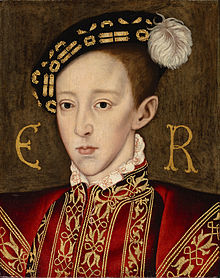The coronation of England’s first Protestant king
Edward VI (1537-53) was the son of Henry VIII and his third wife, Jane Seymour. Though his father had withdrawn the English Church from obedience to Rome, it was still entirely Catholic in liturgy and theology. Edward, however, was raised among Protestant sympathizers and teachers and during his short reign the nation adopted Protestant church policies.
When his father died in 1547, Edward succeeded to the throne ahead of his older half-sisters, Mary and Elizabeth. Those at court who leaned toward religious reform now became instantly bolder. Thomas Cranmer, the Archbishop of Canterbury, preached a sermon at Edward’s coronation calling the new king a second “Josiah” (a young king of Judah in the 7th century B.C. who attacked idols) and called for him to ensure the “the tyranny of the Bishops of Rome banished from your subjects, and images removed”.
During Edward’s reign, all which was spent under the guidance of regents, clerical celibacy and the mass were abolished, a Protestant Book of Common Prayer was ordained and the last elements of monasticism were eradicated. Continental reformers were sought as preachers and university teachers. Catholic incumbents who resisted these changes were removed and in some cases imprisoned. In the process, ecclesiastical lands were seized by well-connected courtiers and the English church structure was much weakened.
Edward’s religious reforms seemed doomed when he died at age 15 to be succeeded by his Catholic half-sister Mary whose persecution of Protestantism won her the name “Bloody Mary” but she too died after a brief reign and without issue. The church instituted under Elizabeth I who reigned from 1558 was built on the Edwardian mode.
